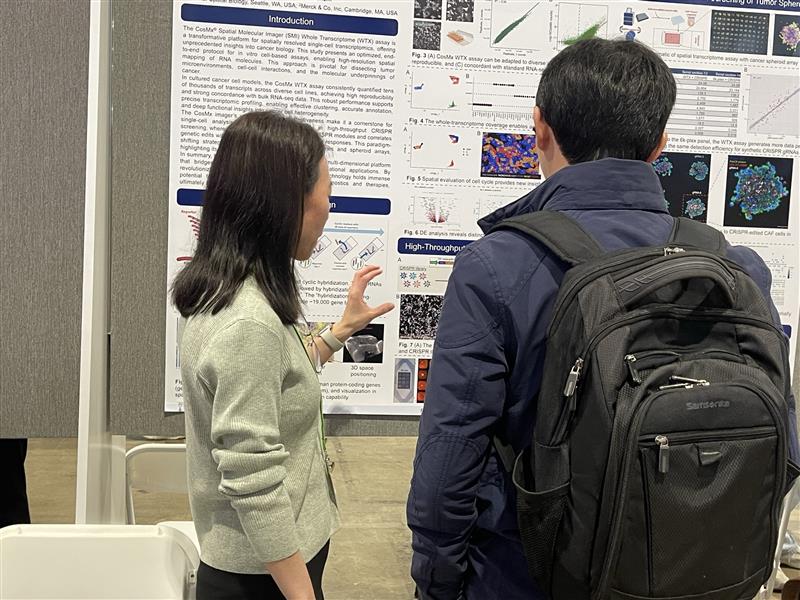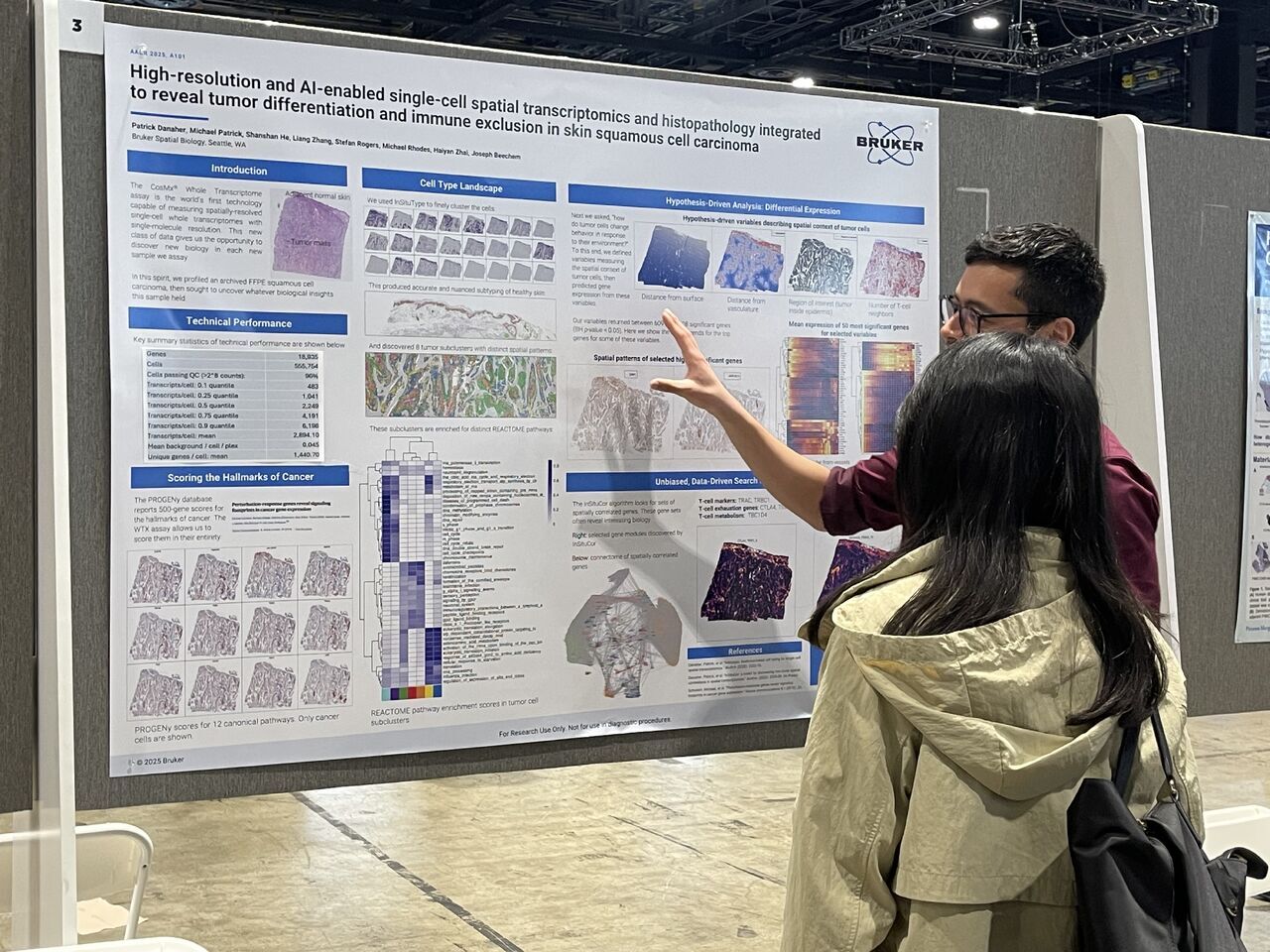Spatial Biology Takes Center Stage at AACR 2025

This year’s American Association for Cancer Research (AACR) Annual Meeting highlighted the power of spatial and multiomics technologies to illuminate the cellular and molecular complexity of cancer. Across all five of our platforms, we and our collaborators presented data-driven approaches to decoding tissue architecture, immune dynamics, 3D genome structure, and therapeutic mechanisms with best-in-class resolution and scale. Explore the poster highlights below to see how our spatial biology and gene expression solutions are powering oncology research from discovery to translation.

Missed our Bruker Spatial Biology Spotlight Theater presentation? Watch on-demand now!
Explore the Power of Spatial Whole Transcriptome Analysis at Subcellular Scale
We unveiled a series of new studies demonstrating how the CosMx® Human Whole Transcriptome (WTX) assay is transforming cancer research. These posters highlight how CosMx WTX delivers spatially resolved, single-cell transcriptomic and proteomic data across a wide range of tissues and experimental models, from FFPE tumors to CRISPR-edited spheroids. Here are some key highlights:
- Skin, Lung, Kidney, and Breast Tumors: CosMx WTX revealed distinct tumor subtypes, immune evasion signatures, and microenvironmental cues across cancer types. AI-powered tools like InSituType and InSituCor uncovered spatially organized gene modules and pathway activity patterns that traditional approaches cannot resolve. (Posters 751, 2067, 2068, & 2091)
- Colon Cancer Benchmarking: In a direct comparison with scRNA-seq, CosMx WTX demonstrated superior detection of rare cells and more accurate representation of tissue composition, all while preserving spatial context. (Poster 2078)
- CRISPR + CosMx Integration: In partnership with Merck, we used CosMx WTX to map gene edits across thousands of CRISPR-edited tumor spheroids at the single-cell level. (Poster 2779)
- Tissue Microarrays (TMAs): By projecting more than 2,000 measured pathways directly onto tumor and normal tissues, CosMx WTX enabled visualization of epithelial-mesenchymal transition, immune barriers, and tissue-specific pathway activation in a single FFPE section. (Poster 2080)

Next-Generation Spatial Proteomics in Action
The flexibility and performance of the CellScape™ Precise Spatial Proteomics platform were highlighted across multiple posters. With EpicIF™ technology enabling iterative cycles of staining, imaging, and gentle signal removal, the CellScape platform delivers high-plex, single-cell resolution proteomics and multiomic integration on FFPE tissue. Here’s what stood out:
- Tri-Omic Spatial Profiling of the Tumor Microenvironment: In DLBCL samples, researchers leveraged the flexibility of the CellScape platform to combine protein, RNA, and in situ protein-protein interaction data—using isPLA, RNA-FISH, and multiplex immunofluorescence. This integrated, multimodal approach enabled the discovery of immune suppression signatures, demonstrating the power of customizable workflows to reveal complex biological insights (Poster 2084)
- CAR-T Cell Tracking in Solid Tumors: In a collaboration with St. Jude, researchers deployed a multiomic assay to track CAR-T cells in mouse xenografts. The CellScape platform enabled spatial mapping of CAR expression, T cell subtype, and effector function to identify CAR-T engagement and persistence in solid tumors. (Poster 1372)
- Triple-Negative Breast Cancer in Black Women: A multi-institutional effort used a 65-plex immune-oncology panel to build a spatial atlas of breast tumors from women of African ancestry. The CellScape platform helped identify immune infiltration, tumor structure, and checkpoint interactions to better understand the biological context of health disparities. (Poster 7106)
- Robust, Reproducible, and Fast Spatial Analyses: From highly validated VistaPlex™ Assay Kits to increasing throughput with FalconFAST™ scanning mode, the CellScape platform continues to expand on its capabilities to support deep phenotyping of tumor and immune cell neighborhoods, including in breast, melanoma, and colon tumors. (Posters 177 & 6483)
High-Plex Spatial Multiomics for Discovery Research
We introduced the GeoMx® Discovery Proteome Atlas (DPA), a 1,100+ plex protein assay designed to pair seamlessly with the 18,000+ plex GeoMx Whole Transcriptome Atlas. Together, they enable same-section spatial profiling of RNA and protein targets across diverse tissues and cell types. This multiomic approach demonstrated high sensitivity, reproducibility, and improved biological resolution, making the GeoMx Digital Spatial Profiler a powerful, comprehensive platform for high-throughput discovery multiomics in cancer research. (Poster 1880)

Streamlining ADC Development with Targeted Transcriptomics
One poster showcased how the nCounter® ADC Development Panel supports high-throughput molecular characterization of antibody–drug conjugates (ADCs) using 3D tumor spheroid models. The study demonstrated that 3D spheroids better recapitulate tumor-like gene expression profiles compared to 2D cultures, revealing distinct patterns in drug efflux and permeability-related genes. The nCounter platform delivered robust performance across fragmented RNA samples, reinforcing its value for ADC-focused discovery and clinical studies. (Poster 1230)
Visualizing Genomic Architecture in Breast Cancer
Our newest instrument, the PaintScape™ platform, enables in situ, single-cell visualization of 3D genome architecture in cancer. We used PaintScape, powered by jebFISH™ technology, to map structural genome differences across localized, metastatic, and triple-negative breast cancer models. The studies revealed distinct patterns of chromatin folding, copy number variation, and interchromosomal interactions linked to oncogenic pathways and cancer metastasis. The PaintScape platform also detected extrachromosomal DNA (ecDNA) and topologically associated domain (TAD) disruptions associated with aggressive disease states, highlighting its utility for investigating genome organization as a driver of tumor progression. (Posters 2746 & 2852)